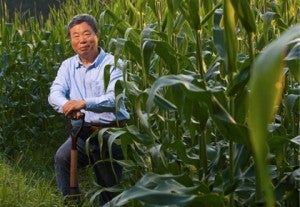Remembering an agricultural pioneer

You may not know the name Dr. Changsheng Li, who passed away last week after a courageous battle with cancer, but his legacy will live on for generations.
A professor at the University of New Hampshire (UNH), Dr. Changsheng developed and refined a model that has been used in more than 20 countries to calculate methane and nitrous oxide emissions from crop production.
A UNH faculty award from 2009 noted that “it is rare to meet a person who fairly radiates humility and compassion. Changsheng Li of the Institute for the Study of Earth, Oceans, and Space is just such an individual.” He will be sorely missed by his friends at Environmental Defense Fund – and across the entire agricultural world.
His work took on new meaning and unprecedented momentum over the past few months with several big developments in the field of agricultural carbon markets – successes that would not have been possible without his pioneering work.
DNDC model
The “DNDC model” (DeNitrification DeComposition) Dr. Changsheng created simulates agricultural greenhouse gas emissions (nitrous oxide, carbon dioxide, and methane) in any ecosystem, in any climate, and in any country. During the past two decades, the DNDC model has been progressively expanded to include agricultural systems such as wetlands, rice paddies, grazed pastures, and forests.
Agriculture accounts for nearly 15 percent of global greenhouse gas (GHG) emissions and will be disproportionately impacted by changing weather patterns. By understanding how emissions are generated in agriculture, organizations such as EDF have been able to implement effective solutions that not only help the planet, but also help farmers save time and generate additional revenue.
Carbon markets legacy
This past June, the first carbon offset protocol for crop-based agriculture was approved for U.S. rice growers by the California Air Resources Board, who can now earn carbon credits – and revenue – for conservation practices that reduce methane. The backbone of the protocol was the DNDC model.
Approval of the rice protocol was followed in September by the U.S. Department of Agriculture’s support of another market-based approach for growers: a fertilizer protocol. More than 400 million acres of cropland could be eligible for participation under fertilizer protocols, and growers could contribute millions of tons of GHG reductions. We expect DNDC will play a key role in helping us meet those objectives.
The rice protocol – and the momentum that followed – would not have been possible without Dr. Changsheng’s work.
An international inspiration
Although often soft-spoken, Dr. Changsheng was a political dissident exiled from his homeland for voicing public support for the 1989 Tiananmen Square pro-democracy uprising while he was working at the U.S. Environmental Protection Agency.
Yet he returned to China periodically to talk about the DNDC model’s potential to improve agriculture in China. UNH colleagues noted that he wanted to “someday go home to save China from its own success.”
His work will always be remembered as the catalyst that facilitated significant emissions reductions in agriculture and helped farmers. But it’s not just farmers that will benefit from his research – future generations will have Dr. Changsheng to thank for sustainable agriculture.












